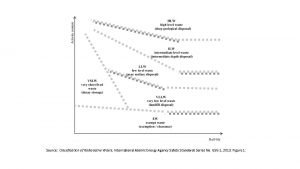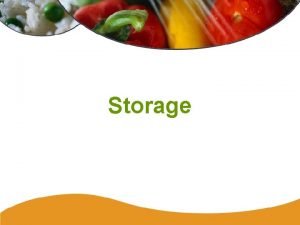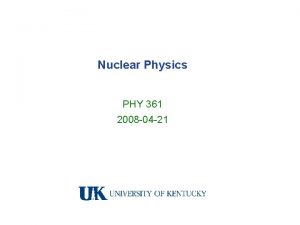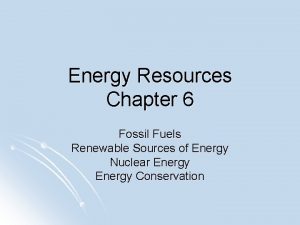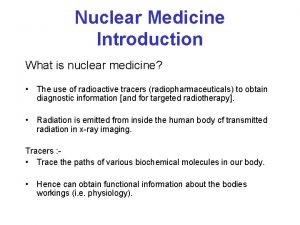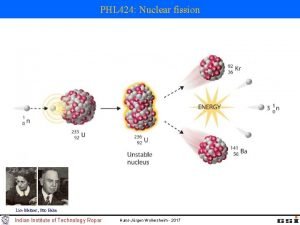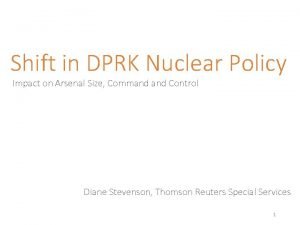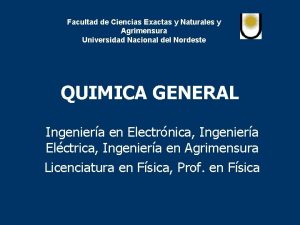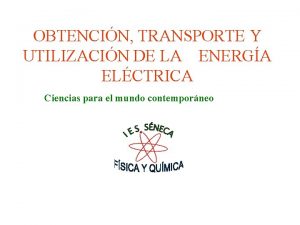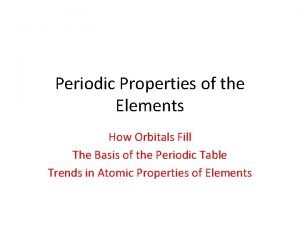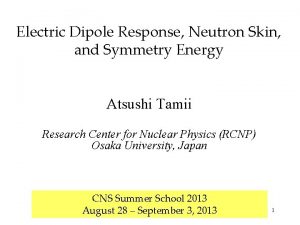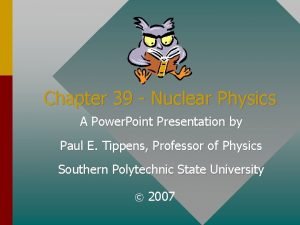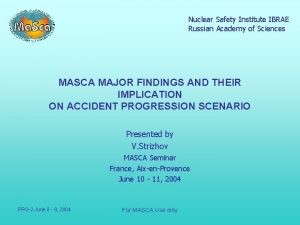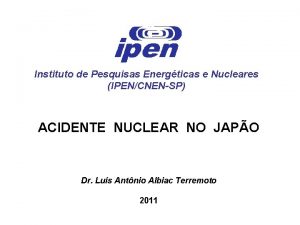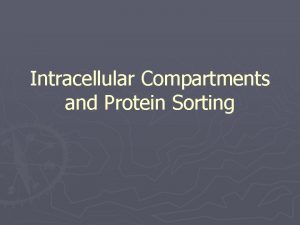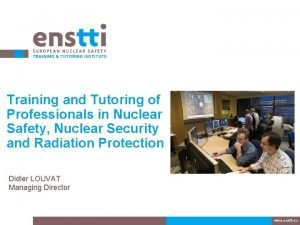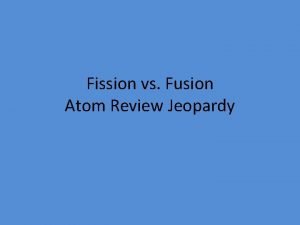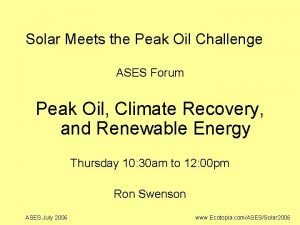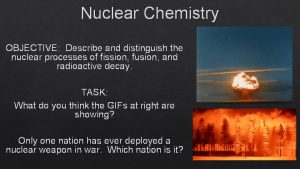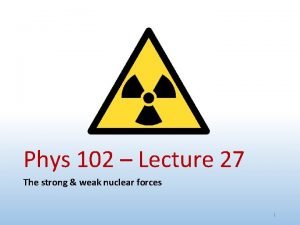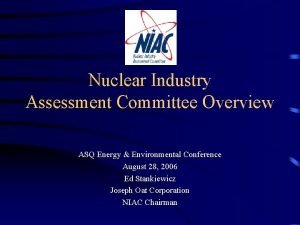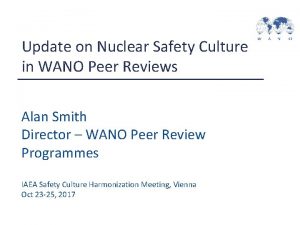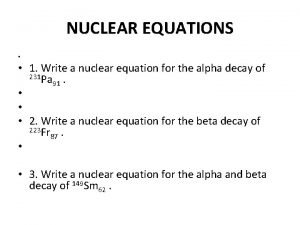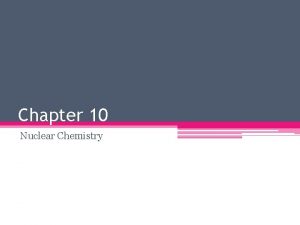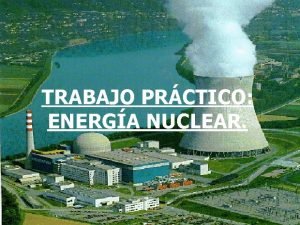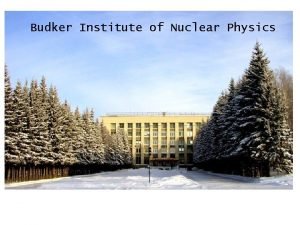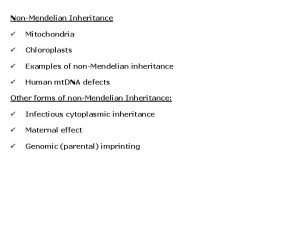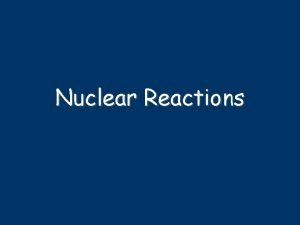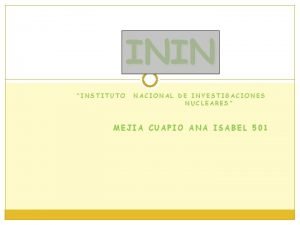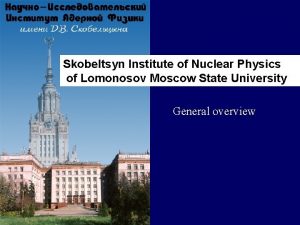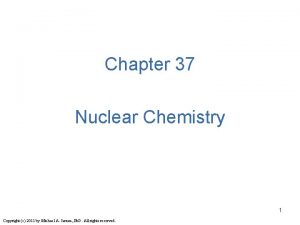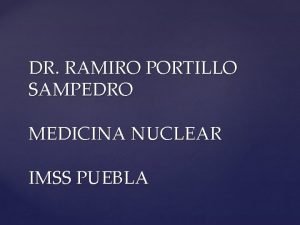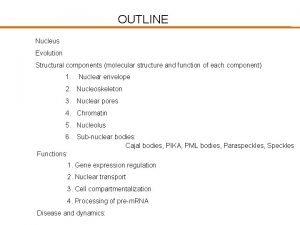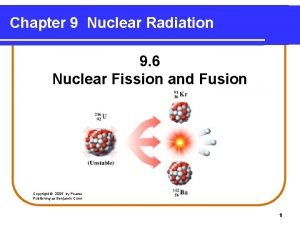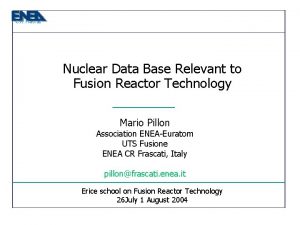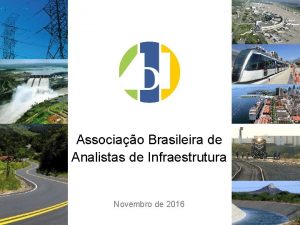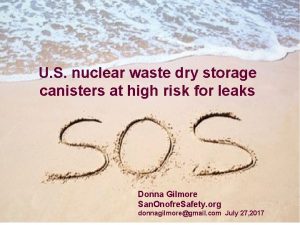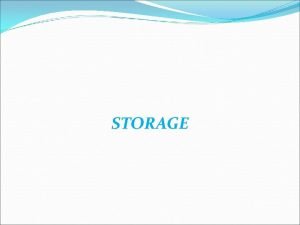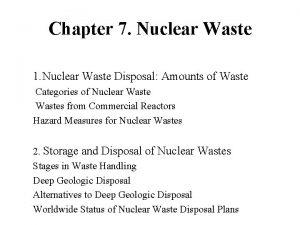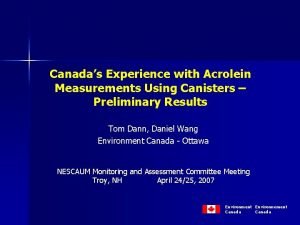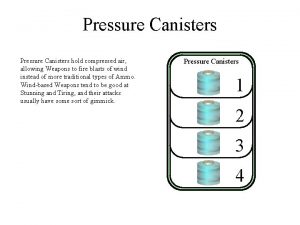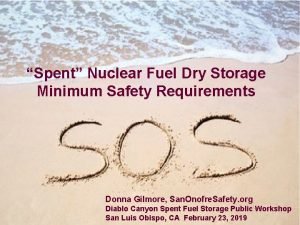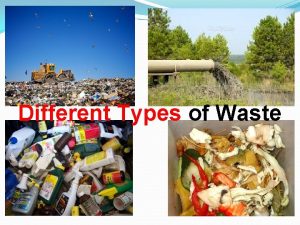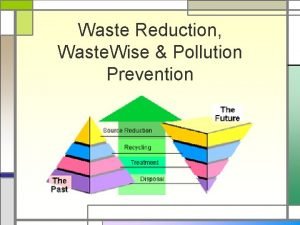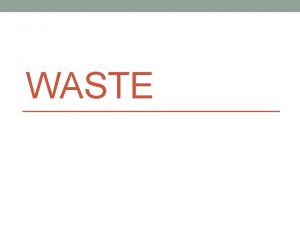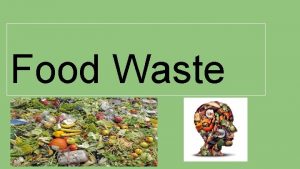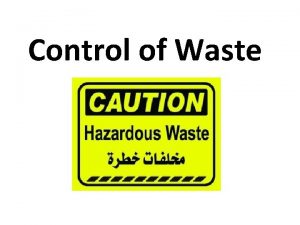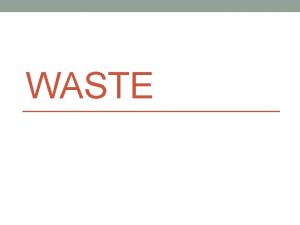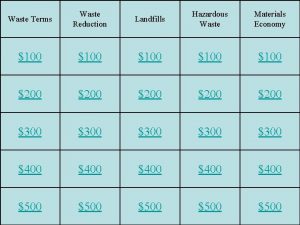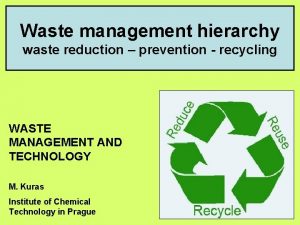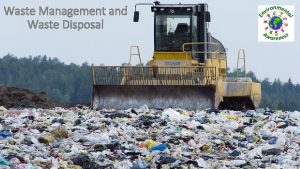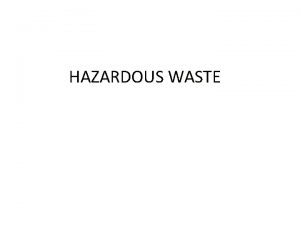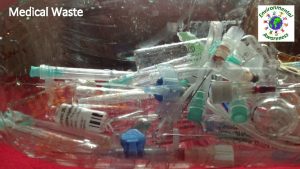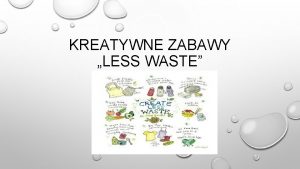U S nuclear waste dry storage canisters at


















































- Slides: 50

U. S. nuclear waste dry storage canisters at high risk for leaks Donna Gilmore San. Onofre. Safety. org donnagilmore@gmail. com January 14, 2018

Risks of short-term cracks and leaks from thin-wall nuclear waste “Chernobyl” canisters n Over 2000 U. S. nuclear waste thin-wall storage canisters n n n Cannot be inspected inside or out Cannot be repaired or maintained Cannot be monitored to prevent radiation leaks n Thin-wall (~ ½”) stainless steel canisters can cracks and leak in the short-term from various environmental and manufacturing conditions. n Can leak 16 years after cracks start and there is no plan in place to deal with this. NRC 8/5/2014 n Would you buy a car that cannot be inspected, repaired or maintained and has no early warning system to prevent failure? San. Onofre. Safety. org 2

Holtec HI-STORM 100 thin-wall canister system Only 1/2 inch thick walls Cannot inspect outside Cannot inspect inside Cannot repair No warning until after leaks Air vents in concrete will accelerate release of radionuclides n No adequate plan for failure n Even partially cracked canisters cannot be transported n Holtec claims 100 - 300 year lifespan by ignoring data n n n San. Onofre. Safety. org 3

Koeberg tank leaked in only 17 years n The Koeberg nuclear plant in South Africa had a comparable container leak in only 17 years from marine environment. n Cracks were deeper than the thickness of most U. S. thin-wall canisters (0. 61” vs 0. 50”). n The NRC considers the Koeberg refueling water storage tank (RWST) comparable operating experience to thin-wall canisters. NRC 8/5/2014 San. Onofre. Safety. org 4

Two-year old Diablo Canyon Holtec canister has conditions for cracking n Temperature low enough to initiate cracks in 2 years <85°C (185°F). n NRC thought it would be 30 years before the temperature was low enough for moisture to stay on a canister and dissolve the salt. Salt is one of the triggers for corrosion & cracks. San. Onofre. Safety. org 5

Frequent fog and on-shore surf at San Onofre and Diablo Canyon increases crack risks NRC and EPRI ignore weather data, claiming insufficient humidity at San Onofre and Diablo Canyon. San. Onofre. Safety. org 6

Holtec canister President Kris Singh admits problems n “It is not n practical to repair a canister if it were damaged… You will have, in the face of millions of curies of radioactivity coming out of canister; we think it’s not a path forward. ” − Dr. Kris Singh, Holtec CEO & President http: //youtu. be/eua. FZt 0 YPi 4 San. Onofre. Safety. org 7

San Onofre (SONGS): 89 times more lethal Cesium-137 than released from Chernobyl R. Alvarez San. Onofre. Safety. org 8

Criticality and explosion risks with cracking cans n Holtec and NRC admit (unborated) water in canister will cause criticality – an uncontrolled release of radionuclides n n NRC assumes no through-wall cracks and no water will enter canister from lake, river, ocean, rain, flood, tsunami, fog) Boron metal in fuel basket is only for criticality prevention while transferring fuel assemblies from borated pool to dry storage. n Hydride buildup from mid and high burnup fuel can trigger hydrogen explosion if exposed to oxygen n Zirconium hydrides (fuel rod – cladding) n Uranium hydrides (fuel pellets) n Aluminum hydrides (fuel assembly basket) San. Onofre. Safety. org 9

Other nations use safer thick-wall metal casks Safety Features Thin-wall canisters Thick-wall casks Thick walls 1/2”- 5/8” 10” to over 19” Won’t crack, maintainable √ Ability to repair, replace seals √ Ability to inspect outside, inside √ Early warning monitoring, continuous, prevents leaks √ ASME container certification √ Defense in depth (redundancy) √ Stored in concrete building √ Gamma & neutron protection Vented concrete overpack Thick Cask √ √ Transportable w/o add’l cask Market leader Thin Canister U. S. World San. Onofre. Safety. org 10

Fukushima thick casks stored in building San. Onofre. Safety. org 11

German thick-wall cask storage over 40 years San. Onofre. Safety. org 12

NRC ignores regulations, laws and reality n n n n NRC transport regulations require intact canisters -- no partial cracks Mark Lombard, NRC Director SFM Division Nuclear Waste Policy Act (NWPA) Donna Gilmore, San. Onofre. Safety. org requires monitored retrievable storage. NUREG-1927 Rev. 1 requires aging management, but requirements vague and cannot be implemented. Aging management issues ignored in canister license. Refuses to raise waste storage standards in spite of NRC admission canisters may need to stay on-site indefinitely. (Policy decision by Mark Lombard) Allows destruction of empty pools, eliminating the only approved and available method to unload failing canisters or fuel. NRC ignores risks of high burnup fuel in storage and transport. San. Onofre. Safety. org 13

High Burnup Fuel n High burnup fuel (HBF) is over twice as radioactive, over twice as hot, and unstable in storage & transport. n n n Fuel burned longer in the reactor results in Zirconium fuel cladding becoming more brittle. Brittle cladding can shatter like glass. (Zirconium is also used in fireworks). Yucca Mountain was not designed for high burnup fuel. HBF can damage cladding after dry storage, but since canisters are welded shut, we have no idea the condition of the cladding. Japan outlawed aluminum alloy fuel assembly baskets. The U. S. still uses them. If baskets fail, fuel may go critical. NRC approved one HBF transport cask by hiding justification. NRC continues to allow higher and higher burnups in reactors in spite of the evidence of HBF impact on storage and transport. n HBF creates more hydrides, increasing explosion risk if fuel is partially exposed to air in pools or dry storage. n Medium burnup fuel also creates hydrides. Higher burnup correlates with more hydrides based on evaluation of HBF rods from reactors. San. Onofre. Safety. org 14

San. Onofre. Safety. org 15

Unproven Holtec UMAX system receives Conditional CA Coastal Permit n Fix problems AFTER 20 years -- impossible! n n n Unproven Holtec UMAX system San Onofre design not NRC approved Cannot inspect, repair, monitor Cannot transport with cracks In ground system even less inspectible Concrete & steel subject to more moisture and corrosion n Holtec warranty n n n No drain 10 years for underground structure 25 years for thin-walled (1/2” to 5/8”) canisters 2 years for existing 51 San Onofre thin-walled canisters San. Onofre. Safety. org 16

Experimental San Onofre Holtec storage system in highly corrosive environment Uninspectable system with no drains in holes. Sea wall not maintained, so no tsunami protection. 73 Holtec cans loading 2018 51 Areva NUHOMS cans loaded above ground, behind Holtec holes (oldest in 2003) San. Onofre. Safety. org 17

When can thin-wall canisters leak? n Most thin cans installed less than 10 years. A few over 20 years. Oldest are: n 1989 (Robinson, H. B. , South Carolina) n 1990 (Oconee, South Carolina) n 1993 (Calvert Cliffs, Maryland) n U. S. commercial spent fuel canisters and casks loaded as of June 2013 (2 pages, sorted by state, includes first year loaded) n https: //sanonofresafety. files. wordpress. com/2015/10/d 32 caskinventorybystate 2017 -05 -18. pdf n Other reports at San. Onofre. Safety. org. For example, damaged fuel assemblies: n New York and Illinois take the “prize” for most damaged fuel assemblies. New York =1399, Illinois =1073 as of 6/30/2013 San. Onofre. Safety. org 18

Consolidated Interim Storage? New Mexico, Texas and DOE plans are flawed n Uses existing inferior canisters. Canisters may already have cracks. These cannot be inspected, repaired or transported. n No plan to prevent leaks in storage and transport and no plan if does leak. No pools. n Transport infrastructure problems not addressed. n New Mexico, Texas and others are being deceived about canister safety n Inadequate aging management plan. n Unnecessary accident risks in transport and new storage. n Legal challenges likely n Proposed bills eliminate current NWPA requirements for monitored retrievable storage and redirects permanent repository funds. n Provides false hope to communities with nuclear waste, so they do not focus on advocating for safer storage containers. n San. Onofre. Safety. org 19

Recommendations n Inform public, media, local, state and federal elected officials and regulators. n Advocate for safer nuclear waste storage standards. n n n n Nuclear waste containers for highly radioactive spent nuclear fuel and for other nuclear waste must be able to be inspected (inside and outside), maintained, repaired and continuously monitored to prevent radiation leaks. Don’t destroy empty spent fuel pools until nuclear waste removed from site. Design for longer term storage (e. g. , no cracking risks) Include Hardened On-Site Storage safety and security standards. Independent quality control Stop installing thin-wall canister systems and stop making more waste. While on-site, select best temporary location at site (e. g. , away from coastal erosion). Replace at risk canisters before they leak. n Thin-wall canisters will cost more due to short lifespan and risks. San. Onofre. Safety. org 20

Donna Gilmore San. Onofre. Safety. org donnagilmore@gmail. com

Additional Background Slides San. Onofre. Safety. org 22

B San. Onofre. Safety. org 23

Roadblocks to moving waste n Yucca Mountain geological repository issues unresolved n DOE plan: Solve water intrusion issue 100 years AFTER loading nuclear waste Inadequate capacity for all waste, not designed for high burnup fuel Numerous technical, legal and political issues unresolved n Congress limited DOE to consider only Yucca Mountain n Funding of storage sites unresolved Communities do not want the waste n n False promises & leaking DOE waste sites n n n WIPP repository leaked within 15 years – broken promises to New Mexico Hanford, WA, Savannah River and other sites leaking State have no legal authority over radiation safety – only cost and permits n Transport infrastructure issues, accident risks, cracking canisters n High burnup fuel over twice as radioactive, hotter, and unstable n Zirconium cladding more likely to become brittle and crack -- eliminates key defense in depth. Radiation protection limited to the thin stainless steel canister. Concrete overpack/cask only protects from gamma and neutrons. n Fuel assemblies damaged after storage may not be retrievable n Inspection of damaged fuel assemblies is imperfect San. Onofre. Safety. org 24

San. Onofre. Safety. org 25

NRC license excludes aging issues n Ignores issues that may occur after initial 20 year license, such as cracking and other aging issues n Refuses to evaluate thick casks unless vendor applies n Requires first canister inspection after 25 years n Allowing 5 years to develop inspection technology n Requires inspection of only one canister plant n That same canister to be inspected once every 5 years n Allows up to a 75% through-wall crack n No seismic rating for cracked canisters n No replacement plan for cracked canisters n Approves destroying fuel pools after emptied n No fuel pools at Humboldt Bay and Rancho Seco n No money allocated for replacement canisters n NRC standards revision (NUREG-1927) scheduled for 2015 San. Onofre. Safety. org 26

Condition of existing canisters unknown n No technology exists to inspect canisters for cracks n Most thin canisters in use less than 20 years n Won’t know until AFTER leaks radiation n Similar steel components at nuclear plants failed in 11 to 33 years at ambient temperatures ~20°C (68°F) n Crack growth rate about four times faster at higher temperatures n 80ºC (176°F) in “wicking” tests compared with 50°C (122°F) n Crack initiation unpredictable n Cracks more likely to occur at higher end of temperature range up to 80°C (176°F) instead of ambient temperatures n Canister temperatures above 85°C will not crack from marine air – chloride salts won’t stay and dissolve on canister n Many corrosion factors not addressed. NRC focus is chloride -induced stress corrosion cracking (CISCC). San. Onofre. Safety. org 27

Koeberg steel tank failed in 17 years n CA coastal environment similar to Koeberg plant in South Africa n Salt and high moisture from on shore winds, surf and fog n EPRI excluded these factors in their crack analysis n Koeberg refueling water storage tank failed with 0. 6” deep crack n EPRI excluded this fact in their crack analysis (cherry picked data) n CA thin canisters only 0. 5” to 0. 625” thick n Diablo Canyon 0. 5” steel canister, inside vented concrete cask n Humboldt Bay 0. 5” steel canister inside thick bolted lid steel cask, inside experimental underground concrete system n Rancho Seco 0. 5” steel canister inside vented concrete overpack n Also at risk from salt air and fog n San Onofre 0. 625” steel canister inside vented concrete overpack n San Onofre proposed Holtec vented underground HI-STORM UMAX system not used anywhere in the world & not approved n Koeberg cracks could only be found with dye penetrant test n Test cannot be used with canisters filled with spent nuclear fuel San. Onofre. Safety. org 28

Can’t repair canisters and No plan to replace them n “It is not practical to repair a canister if it were damaged … if that canister were to develop a leak, let’s be realistic; you have to find it, that crack, where it might be, and then find the means to repair it. You will have, in the face of millions of curies of radioactivity coming out of canister; we think it’s not a path forward. ” − Dr. Kris Singh, Holtec CEO & President http: //youtu. be/eua. FZt 0 YPi 4 n No plan to replace casks or cracked canisters n n n NRC allows pools to be destroyed, removing the only available method to replace canisters and casks No plans or funds to replace pools or spent fuel dry storage systems Dry transfer systems don’t exist for this and are too expensive Transporting cracked canisters is unsafe & not NRC approved Storing failed canister in a thick transport cask is no path forward, expensive & not NRC approved No seismic rating for a cracked canisters San. Onofre. Safety. org 29

San. Onofre. Safety. org 30

Thick casks designed for longer storage n n n Market leader internationally No stress corrosion cracking Maintainable n n n n n Not currently licensed in U. S. (18 to 30 month process) Vendors won’t request NRC license unless they have customer Thick cask body − forged steel or thick ductile cast iron up to 20” Early warning before radiation leak (remote lid pressure monitoring) Cask protects from all radiation, unlike thin steel canisters. n n n Inspectable Replaceable parts (metal seals, lids, bolts) Double bolted thick steel lids allow reloading without destroying cask 40 years in service with insignificant material aging. Option for permanent storage with added welded lid. No concrete overpack required (reduced cost and handling) No transfer or transport overpack required (reduced cost and handling) Stored in concrete building for additional protection Used for both storage and transportation (with transport shock absorbers) ASME & international cask certifications for storage and transport Damage fuel sealed (in ductile cast iron casks) San. Onofre. Safety. org 31

Game Changer Indefinite on-site storage n 2014 NRC continued storage decision* 100+ years on-site storage n Reload canisters every 100 years No other storage sites on horizon Canisters may fail in 20 to 30 years n Some may already have cracks Cannot inspect for or repair corrosion and cracks n No warning until after radiation leaks into the environment Diablo Canyon Holtec thin canister has conditions for cracking after only 2 years! No replacement plan for failure n n n *GEIS analyzed the environmental impact of storing spent fuel beyond the licensed operating life of reactors over three timeframes: 60 years (short-term), 100 years after the short-term scenario and indefinitely, August 26, 2014. [assuming 40 year license: 60+40 = 100 (short term)] San. Onofre. Safety. org 32

No warning before radiation leaks from thin canisters n No early warning monitoring n Remote temperature monitoring not early warning n No pressure or helium monitoring n Thick casks have continuous remote pressure monitoring – alerts to early helium leak n No remote or continuous canister radiation monitoring n Workers walk around canisters with a “radiation monitor on a stick” once every 3 months n Thick casks have continuous remote radiation monitoring n After pools emptied, NRC allows n Removal of all radiation monitors n Elimination of emergency planning to communities – no radiation alerts n Removal of fuel pools (assumes nothing will go wrong with canisters) n Humboldt Bay & Rancho Seco pools destroyed San. Onofre. Safety. org 33

References n Diablo Canyon: conditions for stress corrosion cracking in two years, D. Gilmore, October 23, 2014 https: //sanonofresafety. files. wordpress. com/2011/11/diablocanyonscc-2014 -10 -23. pdf n Reasons to buy thick nuclear waste dry storage casks and myths about nuclear waste storage, April 16, 2015, D. Gilmore https: //sanonofresafety. files. wordpress. com/2011/11/reasonstobuythickcasks 2015 -04 -16. pdf n Donna Gilmore’s CPUC Pre-Hearing Conference Statement (A 1412007), March 20, 2015 http: //docs. cpuc. ca. gov/Published. Docs/Efile/G 000/M 148/K 824/148824935. PDF n Additional references: San. Onofre. Safety. org 34

Sandia Labs: Ductile cast iron performs in an exemplary manner n Safe from brittle fracture in transport n …studies cited show DI [ductile iron] has sufficient fracture toughness to produce a containment boundary for radioactive material transport packagings that will be safe from brittle fracture. n Exceeds drop test standards n …studies indicate that even with drop tests exceeding the severity of those specified in 1 OCFR 7 1 the DI packagings perform in an exemplary manner. n Exceeds low temperature requirements n Low temperature brittle fracture not an issue. The DCI casks were tested at -29°C and -49°C exceeding NRC requirements. n Conclusions shared by ASTM, ASME, and IAEA n Fracture Mechanics Based Design for Radioactive Material Transport Packagings Historical Review, Sandia Labs, SAND 98 -0764 UC-804, April 1998 http: //www. osti. gov/scitech/servlets/purl/654001 San. Onofre. Safety. org 35

Thin canisters not ASME certified n Canisters do not have independent quality n n certification from American Society of Mechanical Engineers (ASME) NRC allows exemptions to some ASME standards No independent quality inspections ASME has not developed standards for spent fuel stainless steel canisters Quality control has been an issue with thin canisters San. Onofre. Safety. org 36

Fukushima thick casks San. Onofre. Safety. org 37

Thin canisters not designed to be replaced n Welded lid not designed to be removed n Lid must be unwelded under water n Fuel transfer from damaged canister to new canister must be done under water n No spent fuel has ever been reloaded into another thin canister n Thick casks are designed to remove and reload fuel n Potential problem unloading fuel from a dry storage canister or cask into a pool with existing fuel San. Onofre. Safety. org 38

No defense in depth in thin canisters n No protection from gamma or neutron radiation in thin canister n Unsealed concrete overpack/cask required for gamma & neutrons n No other type of radiation protection if thin canister leaks n Thick steel overpack transfer cask required to transfer from pool n Thick steel overpack transport cask required for transport n High burnup fuel (HBF) (>45 GWd/MTU) n Burns longer in the reactor, making utilities more money n Over twice as radioactive and over twice as hot n Damages protective Zirconium fuel cladding even after dry storage n Unstable and unpredictable in storage and transport n Limited technology to examine fuel assemblies for damage n Damaged fuel cans vented so no radiation protection n Allows retrievability of fuel assembly into another container San. Onofre. Safety. org 39

Problems with thin stainless steel canisters n Not maintainable n Cannot inspect exterior or interior for cracks n Cannot repair cracks n Not reusable (welded lid) n No warning BEFORE radiation leaks n Canisters not ASME certified n NRC allows exemptions from ASME standards n No defense in depth n Concrete overpack vented n Unsealed damaged fuel cans n No adequate plan for failed canisters n Early stress corrosion cracking risk n Inadequate aging management plan San. Onofre. Safety. org 40

San. Onofre. Safety. org 41

San. Onofre. Safety. org 42

San. Onofre. Safety. org 43

San. Onofre. Safety. org 44

San. Onofre. Safety. org 45

High Burnup Fuel Approval June 1992 Up to 60 GWd/MTU (60 MWD/kg) San. Onofre. Safety. org 46

Thin canisters cannot be inspected n No technology to detect surface cracks, crevice and pitting corrosion in thin canisters filled with nuclear waste n n n Canister must stay inside concrete overpack/cask due to radiation risk, so future inspection technology may be limited Thin canisters do not protect from gamma and neutrons Microscopic crevices can result in cracks n Thick casks can be inspected n n n Provide full radiation barrier without concrete Surfaces can be inspected Not subject to stress corrosion cracking San. Onofre. Safety. org 47

Recommendations to NRC n Require best technology used internationally n Base standards on longer term storage and transport needs Not on limitations of thin canister technology n Not on vendor promises of future solutions Store in hardened concrete buildings Don’t destroy defueled pools until waste stored off-site Transfer fuel from thin-wall canisters – may require on-site “hot cell” Install continuous radiation monitors with on-line public access Continue emergency plans until waste is off-site Certify safety of dry storage systems for 100 years, but require 20 -year license renewals n n n n San. Onofre. Safety. org 48

Recommendations We cannot kick this can down the road n STOP thin canister procurement n Develop minimum dry storage requirements to ensure adequate funding for new 100+ year storage requirements n n n Maintainable – We don’t want to buy these more than once Early warning prior to failure and prior to radiation leaks Inspectable (inside and out), repairable and don’t crack Cost-effective for 100 year storage, transportable Ability to reload fuel without destroying container n Don’t allow purchase of vendor promises (vaporware) n Require bids from leading international vendors n Replace existing thin canisters before they fail – likely requires an on-site “hot cell” (dry fuel handling facility). n Store in hardened concrete buildings n Require mitigation plan n Don’t destroy empty pools until waste removed from site Install continuous radiation monitors with on-line public access Continue emergency planning until waste is off-site San. Onofre. Safety. org 49

Donna Gilmore San. Onofre. Safety. org donnagilmore@gmail. com
 Lesson 15 nuclear quest nuclear reactions
Lesson 15 nuclear quest nuclear reactions Fisión nuclear vs fision nuclear
Fisión nuclear vs fision nuclear Radioactive nuclear waste
Radioactive nuclear waste Types of dry storage
Types of dry storage Secondary storage vs primary storage
Secondary storage vs primary storage Secondary storage vs primary storage
Secondary storage vs primary storage Uses rigid metallic platters
Uses rigid metallic platters Unified storage vs traditional storage
Unified storage vs traditional storage Nuclear physics
Nuclear physics Nucleolus
Nucleolus Nuclear energy vocabulary
Nuclear energy vocabulary Lifestyle medicine
Lifestyle medicine Nuclear propulsion
Nuclear propulsion Mit reactor tour
Mit reactor tour Nuclear fission lise meitner
Nuclear fission lise meitner Nuclear posture
Nuclear posture Energia reticular tabla periodica
Energia reticular tabla periodica Deteccion de pensamientos automaticos beck
Deteccion de pensamientos automaticos beck Como funciona la energia nuclear
Como funciona la energia nuclear Effective nuclear charge trend
Effective nuclear charge trend Nuclear density
Nuclear density Nuclear physics topics for presentation
Nuclear physics topics for presentation Nuclear safety institute of the russian academy of sciences
Nuclear safety institute of the russian academy of sciences Irradiated food
Irradiated food Usina nuclear
Usina nuclear Intracellular compartments and protein sorting
Intracellular compartments and protein sorting Dyadic nuclear adalah
Dyadic nuclear adalah Nuclear safety training
Nuclear safety training Nuclear fission vs fusion venn diagram
Nuclear fission vs fusion venn diagram Peak oil forum
Peak oil forum Atomic bomb shadows
Atomic bomb shadows Psp palsey
Psp palsey Strong vs weak nuclear force
Strong vs weak nuclear force Nuclear industry assessment committee
Nuclear industry assessment committee Wano 10 traits
Wano 10 traits Nuclear equation definition
Nuclear equation definition Chapter 10 nuclear chemistry
Chapter 10 nuclear chemistry Fukushima nuclear flowers imgur
Fukushima nuclear flowers imgur Nuclear concepto
Nuclear concepto Budker institute of nuclear physics
Budker institute of nuclear physics Transovarial transmission คือ
Transovarial transmission คือ Audible and inaudible sound
Audible and inaudible sound Artificial transmutation example
Artificial transmutation example Inin reactor nuclear
Inin reactor nuclear Skobeltsyn institute of nuclear physics
Skobeltsyn institute of nuclear physics Gamma decay nuclear equation
Gamma decay nuclear equation Ramiro vieira
Ramiro vieira Nuclear membrane
Nuclear membrane Nuclear fusion radiation
Nuclear fusion radiation Tecnology
Tecnology Usina nuclear
Usina nuclear


